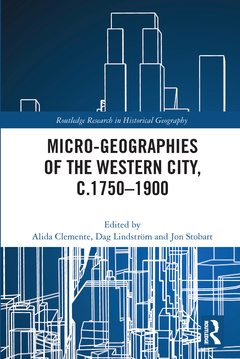Micro-geographies of the Western City, c.1750–1900 Routledge Research in Historical Geography Series
Coordonnateurs : Clemente Alida, Lindström Dag, Stobart Jon

This book examines the overlapping spaces in modern Western cities to explore the small-scale processes that shaped these cities between c.1750 and 1900. It highlights the ways in which time and space matter, framing individual actions and practices and their impact on larger urban processes.
It draws on the original and detailed studies of cities in Europe and North America through a micro-geographical approach to unravel urban practices, experiences and representations at three different scales: the dwelling, the street and the neighbourhood. Part I explores the changing spatiality of housing, examining the complex and contingent relationship between public and private, and commercial and domestic, as well as the relationship between representations and lived experiences. Part II delves into the street as a thoroughfare, connecting the city, but also as a site of contestation over the control and character of urban spaces. Part III draws attention to the neighbourhood as a residential grouping and as a series of spaces connecting flows of people integrating the urban space. Drawing on a range of methodologies, from space syntax and axial analysis to detailed descriptions of individual buildings, this book blends spatial theory and ideas of place with micro-history.
With its fresh perspectives on the Western city created through the built environment and the everyday actions of city dwellers, the book will interest historical geographers, urban historians and architects involved in planning of cities across Europe and North America.
1. Introduction Part 1: Houses and Households: Spaces, Practices, and Representations 2. Toronto’s Early Apartment Houses: A Micro-Geography 3. The Brilliant Idea of the Book-Keeper Johan Peter Frisk: A Micro-Historical Study 4. The Shop and the Home: Commercial and Domestic Space in 18th-Century England 5. Representing a Disreputable House Part 2: Streets and Pavements: Sociability, Improvement, and Conflict 6. Sidewalks and Alignment of the Streets: The Gap between Large-Scale Planning and the Building-Scale in the Eighteenth and Nineteenth Centuries (Brussels-Paris) 7. Liberalism Underfoot: A Micro-Geography of Street Paving and Social Dissolution – Brunswick Avenue, Toronto, Ontario, 1898–99 8. Policing Stockholm’s Filth: Flows to Fixedness, 1776–1836 9. Representing the ‘Other’ Berlin, c. 1900: Micro-geographies of the Proletarian City Part 3: Neighbourhoods: Networks, Spaces, and Identities 10. Public Houses and Hidden Networks: Roles of Women in Mid-19th-Century Montreal 11. The Micro-Geography of Political Meeting Places in Manchester and Sheffield c.1780-1850 12. Trouble at the Edge of Town: Policing Montreal’s Urban Periphery in the Middle of the 19th Century 13. Conclusions
Alida Clemente is Lecturer and Assistant Professor of Economic History at the University of Foggia. She has published on urban and regional economic history of the Mediterranean between the 17th and the 19th centuries, with special regard to fisheries, luxury consumption, and famines.
Dag Lindström is Professor of History at Uppsala University. He has published on urban social and cultural history, history of crime, craft guilds, leisure culture and unmarried adults.
Jon Stobart is Professor of history at Manchester Metropolitan University. He has published on a range of topics with retailing and consumption during the 18th century, including second-hand trade, groceries, shopping practices and the supply and material culture of the country house.
Date de parution : 05-2023
15.6x23.4 cm
Date de parution : 12-2020
15.6x23.4 cm
Thèmes de Micro-geographies of the Western City, c.1750–1900 :
Mots-clés :
Dense; microgeographies; Follow; urban geography; Sir Roger Newdigate; urban spaces; Roger Newdigate; lived histories; Vice Versa; urban built environment; Town Hall; urban experiences; La Minerve; urban histories; Violated; urban historical geography; Lachine Canal; historical geography; Cedar Block; historical geography of the city; Urban Morphology; history of the city; 19th Century Berlin; urban history 1700; Head Of The Family; urban history 1800; Gateway; urban history 1900; St Mary Street; Public houses; Plank Sidewalk; Micro-geographical approach; St Lawrence River; Urban space; Space Syntax; Western city; City Engineer; Hobrecht Plan; Political Meetings; Union Trust Company; Police Chamber; Tib Street; Spatial Culture



